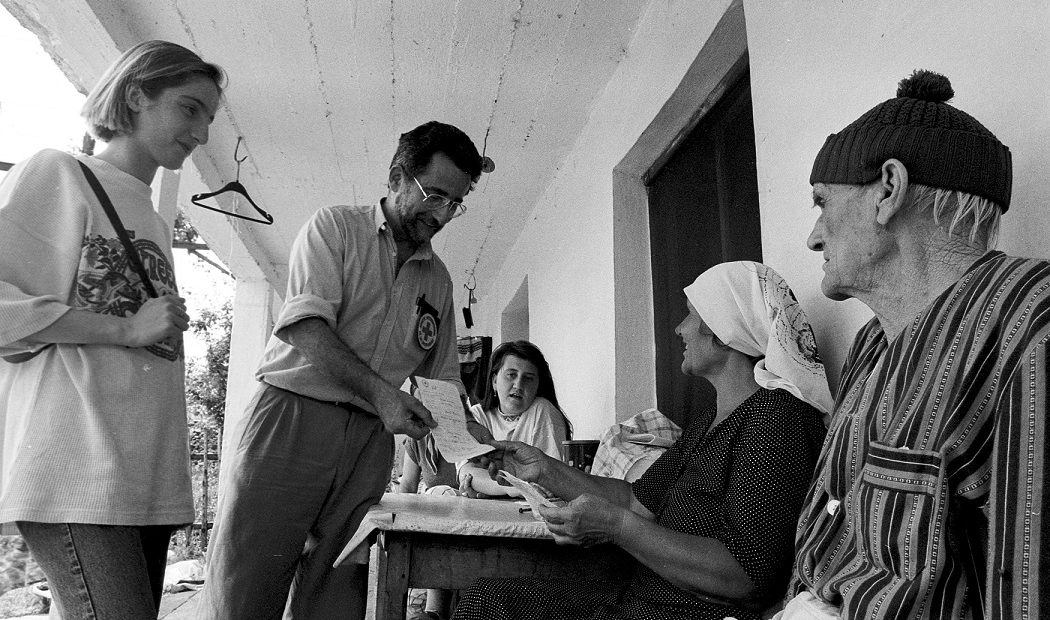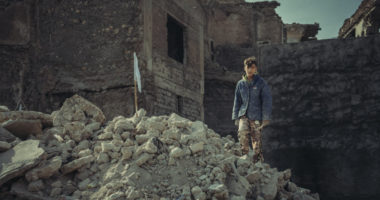Humanitarian actors broadly agree on the humanitarian principles’ meanings and their utility in responses to armed conflict and disasters. But this consensus can oversimplify the principles’ origins and legal character.
In this post, which is based on a longer article forthcoming in the International Review of the Red Cross, international law professor Marina Sharpe examines how the humanitarian principles diffused from the Red Cross Red Crescent Movement to NGOs and the UN, shedding light on their legal character and normative content.
Recent events around the world – including the earthquakes in Syria and Türkiye, the pandemic and new and ongoing armed conflict – have pushed the need for and complexity of international humanitarian action to unprecedented levels. The guidance of, and operational effectiveness fostered by, the humanitarian principles of humanity, impartiality, neutrality and independence are thus as critical as ever.
The humanitarian principles
Robert Mardini described the principles in this series’ launch post. He noted that humanity and impartiality provide ‘a moral compass: humanitarian action aims to prevent and alleviate suffering (humanity) and is driven solely by needs, irrespective of nationality, race, religious beliefs, class or political opinions (impartiality)’. Mardini also explained that neutrality and independence are ‘practical tools for securing access to those affected … They were devised to win the trust, or at least acceptance, of all: neutrality commands that we not take sides, and independence means determining needs and making operational decisions autonomously’.
These explanations reflect a general consensus among humanitarians in every major category – the International Red Cross and Red Crescent Movement (the Movement), NGOs and the UN – regarding the principles’ meanings and their utility. This consensus facilitates communication and coordination in complex operational environments and is even strong enough to allow for divergence, particularly regarding neutrality, and critical reflection and re-evaluation. However, it also risks an oversimplistic understanding of the principles in two ways.
First is the view that the principles are simply derived from the Fundamental Principles of the International Red Cross and Red Crescent Movement (the Fundamental Principles). While it is true that the humanitarian principles have their earliest origins in the Fundamental Principles, this obscures how Movement-specific principles came to also apply to NGOs and UN actors. There is also an idea that the principles are or come from international law, particularly international humanitarian law (IHL). Both likely derive from the consensus around the principles. Their evident value may limit critical questions regarding the principles’ origins, and shared understandings of what each principle means probably contribute to the idea that they emanate from IHL.
In fact, the principles have distinct histories and sources for each major category of humanitarian actor, which helps demonstrate that they do not (and indeed cannot) have universal legal character and normative content under international law. Rather, the humanitarian principles are, as the saying goes, all relative.
History
The principles have a common starting point in the Movement’s now familiar history. In 1859, Swiss businessman Henri Dunant witnessed the bloody aftermath of the Battle of Solferino, which overwhelmed both sides’ capacity to care for injured soldiers. Dunant mobilized a local volunteer response and, following his return to Geneva, authored a book about his transformative experience. Its ideas led to the founding of the International Committee of the Red Cross (ICRC) in 1863 and to the adoption of the very first Geneva Convention a year later.
Antecedents to the modern principles of humanity, impartiality and neutrality are evident in this treaty. For example, Article 5 provides for the neutrality of local people who ‘bring help to the wounded’. The principles of humanity, impartiality and neutrality inspired by the 1864 Geneva Convention, as well as additional principles drawn from other Red Cross sources, governed the Movement informally until 1921, when its principles were codified for the first time in the ICRC’s revised Statutes.
The Movement’s principles developed between 1921 and 1955-56, when ICRC official Jean Pictet published his doctoral thesis on Red Cross doctrine across several issues of the International Review of the Red Cross. In 1965, the Fundamental Principles were officially proclaimed, based largely on Pictet’s work. These Fundamental Principles, which govern the Movement to this day, are humanity, impartiality, neutrality, independence, voluntary service, unity and universality. They were reaffirmed in 1986, when they were incorporated into the preamble to the new Movement Statutes.
The Berlin Wall came down in 1989, bringing the end of the Cold War into view. Around this time, many humanitarian actors realized that armed conflict was about to become significantly more dangerous for civilians and those assisting them, as great power proxy wars would give way to internal armed conflicts. The Movement, NGOs and the UN all responded in ways that shared a common element: humanitarian principles.
The Movement’s response consisted in part of a 1991 call by its Council of Delegates for the International Federation of Red Cross and Red Crescent Societies (IFRC) ‘to set up a group of experts to study the possibility of elaborating a Code of Conduct relative to humanitarian aid in situations of natural and technological [human-made] disasters’.
Several British NGOs also concluded that a code of conduct was necessary, so the IFRC and Oxfam-GB, in consultation with the Steering Committee for Humanitarian Response, worked together to draft one. The outcome of their work was the 1994 ‘Code of Conduct for the International Red Cross and Red Crescent Movement and Non-Governmental Organizations in Disaster Relief’ (the Code of Conduct), which has since been signed by nearly 900 NGOs. (Despite its title, the Code of Conduct applies equally in armed conflict.)
The Code of Conduct was inspired by the Fundamental Principles. It includes the principles of humanity, impartiality and independence (though these are described rather than listed). The Code includes a principle similar to neutrality, but to accommodate faith- and rights-based and ‘Wilsonian’ organizations it allows signatories to espouse political or religious views. It also includes six additional principles. The Code of Conduct was thus the vehicle for the diffusion of the humanitarian principles from the Movement to NGOs more broadly.
Discussions at the UN in New York centered on how post-Cold War civil wars would have a greater impact on civilians, but State sovereignty would frustrate the UN’s humanitarian response. Jan Eliasson, who in 1989 was Sweden’s Permanent Representative to the UN, told me that he and colleagues in other UN missions concluded that the solution should be to reform the UN’s humanitarian architecture.
They achieved this reform in 1991 with the adoption of General Assembly resolution 46/182. The resolution includes a set of ‘Guiding Principles’ for humanitarian assistance of the UN system, the second of which provides that it ‘must be provided in accordance with the principles of humanity, neutrality and impartiality’. Independence was added to the UN’s humanitarian principles in 2003 via General Assembly resolution 58/114. Edward Tsui, a now-retired UN official who was involved in drafting resolution 46/182, recalled that the penholders did not want to ‘reinvent the wheel’ on humanitarian principles, but instead looked to the ICRC for ‘best practices’.
The humanitarian principles thus have common origins in the Fundamental Principles. From there, they migrated to NGOs via the Code of Conduct and to the UN through General Assembly resolutions 46/182 and 58/114. The principles have since appeared in additional non-governmental, UN and other documents. These histories should be interesting in and of themselves and they also begin to reveal the inherent relativity of the principles’ legal character.
Legal character and normative content
The humanitarian principles’ diverse sources have important implications for their legal character. For starters, they help demonstrate that the principles do not emanate from IHL. To constitute international law, the principles would have to derive from one or more of the formal sources of international law (articulated in the Statute of the International Court of Justice): treaties, customary international law and general principles of law. While the 1864 Geneva Convention contains antecedents to the modern humanitarian principles, as shown above the principles do not emanate directly from any of these three sources. Moreover, the Movement and NGOs are not generally governed by international law, which for the most part binds only States and international organizations.
That the humanitarian principles do not come from international law is not to say they are not legally binding. Whether the principles are obligatory depends on their source, which varies by actor. The humanitarian principles are binding for Movement components pursuant to its Statutes (as well as under the Fundamental Principles proclaimed in 1965). They are binding for any NGO that has signed the Code of Conduct; an NGO may also be bound by the principles pursuant to an internal governance document, such as its charter or by-laws.
Whether a given UN actor is bound by the resolution 46/182 obligation to act ‘in accordance with the principles of humanity, neutrality and impartiality’ depends on its relationship to the General Assembly. This is determined by the UN Charter and subsequent practice of its application. Most UN actors engaged in humanitarian action, such as OCHA (which is part of the UN Secretariat), UNFPA, UNHCR, UNICEF, UNRWA and WFP, are bound by resolution 46/182. The paragraph of General Assembly resolution 58/114 relating to independence is not, on the resolution’s language alone, legally binding. However, as a matter of practice all four humanitarian principles are now of equivalent legal status in the UN system.
Despite this range of sources, almost all humanitarian actors agree on each principle’s meaning, as evidenced by similar conceptualizations across the Movement Statutes, the Code of Conduct and a range of UN documentation. This is why Mardini could articulate the principles in terms with which virtually no humanitarian would disagree.
Additionally, IHL is not silent regarding what constitutes humanitarian action. For example, the 1977 Additional Protocols (article 70(1) of the first and article 18(2) of the second) essentially provide that conflict parties may not arbitrarily withhold their consent to outside assistance that is ‘humanitarian’ and ‘impartial’ (and conducted without adverse distinction). Thus while the humanitarian principles do not derive from IHL, at least impartiality is a constitutive element of humanitarian action under IHL. In addition to acting impartially because this is required by the Movement Statutes, the Code of Conduct or General Assembly resolutions, humanitarian actors in armed conflict will act impartially because so doing privileges their assistance under IHL.
Undermining the principles?
Last year, I was discussing this with a friend who is a seasoned humanitarian. She expressed concern, with words to the effect of ‘Do you really want to argue that the humanitarian principles do not come from international law, and that they have different sources for different actors? The principles are valuable because they’re universal. Won’t you undermine that?’.
In fact, while it may initially be counterintuitive, this analysis reinforces the humanitarian principles. The principles do not derive from international law; rather, they have distinct sources for each major category of humanitarian actor. And yet they are nevertheless legally binding, with meanings that have coalesced around virtually identical conceptualizations.
This common normative content derives in part from the principles’ earliest shared origins in the Fundamental Principles. But it also stems from the fact that the principles have guided and facilitated humanitarian action since the end of the Cold War. This is a testament to their value, which will be enhanced by improved understanding of where they came from, why they are obligatory and why their meanings are essentially universal.
The author gratefully acknowledges the research assistance of Hye Joon Lee and Poonam Sandhu; helpful feedback from the blog’s Editor-in-Chief Elizabeth Rushing and the Back to Basics reading committee; and financial support from the Social Sciences and Humanities Research Council of Canada.
See also
- Pierrick Devidal, ‘Back to basics’ with a digital twist: humanitarian principles and dilemmas in the digital age, February 2, 2023
- Nils Melzer & Elizabeth Rushing, Humanitarian neutrality in contemporary armed conflict: a conversation with Nils Melzer, January 26, 2023
- Fiona Terry, Taking action, not sides: the benefits of humanitarian neutrality in war, June 21, 2022
- Robert Mardini, Back to basics: humanitarian principles in contemporary armed conflict, June 16, 2022






Comments